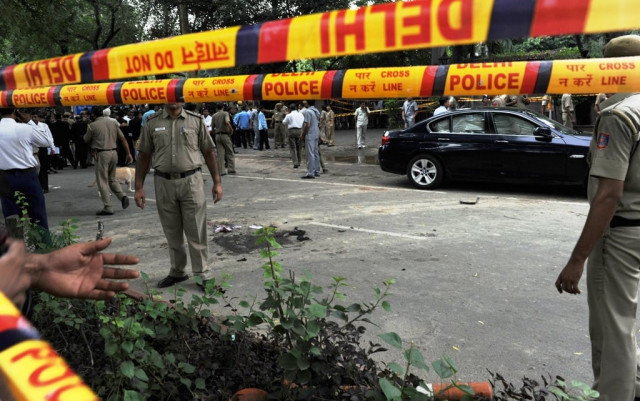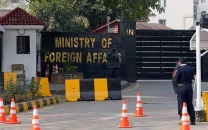India probing bomb claim by Harkatul Jihad Islami
Blast in Delhi high court caused by a bomb inside a briefcase; 11 killed, 76 injured.

The bomb dug a crater three to four feet deep near the main reception counter where passes are issued for lawyers and visitors to enter the sprawling sandstone building before the main security checkpoint.
Authorities said the Harkatul Jihad Islami (HUJI) militant group -- an al Qaeda affiliate with bases in Pakistan and Bangladesh -- had sent an email claiming responsibility.
Ilyas Kashmiri, who US authorities believe was recently killed in Pakistan, was the head of HUJI and a senior al Qaeda member.
Prime Minister Manmohan Singh is on an official visit to Bangladesh, the first visit by an Indian premier in 12 years.
In an email to the National Investigation Agency (NIA), the group called on India to repeal the death sentence of a man convicted in connection with an attack on the Indian parliament in 2001 and warned it would otherwise target major courts in the country.
"That mail has to be looked at very seriously because HUJI is a very prominent terrorist group among whose targets India is one," NIA chief SC Sinha told reporters.
The blast comes as security has been stepped up at key locations as parliament is in session.
It also comes less than two months after near-simultaneous triple bomb attacks in India's financial hub Mumbai killed 24. No one has claimed responsibility for those attacks.
"I was near the gate at that time," said lawyer KK Gautam of Wednesday's attack. "There was an orderly queue when a loud blast occurred. I saw many injured and dead. I saw 20-25 injured and around 10 dead."
The court building compound is in a leafy, usually tranquil and upscale part of the city. The outside gate is usually manned by a handful of policemen armed with automatic rifles and hand-held scanners.
Lawyers in black suits and starched white collars stood around shocked on one of the busiest days of the week when the court hears public interest petitions.
About 120 soldiers, police and bomb squad specialists were at the scene, with ambulances whisking the injured away to hospitals.
Television images showed scores of lawyers running from one of the main gates of the building just after the explosion amid rubble and chaotic scenes. Police cordoned off the area, not far from parliament and the prime minister's office.
"I think I saw this guy (suspect). He was in white, aged 34 or 35, carrying a briefcase and jumping the long queue," an unnamed middle-aged man told Indian television channels.
"There must have been some 80 people at that time when the bomb went off. I crouched immediately but the man behind me, he did not and was hit (by shrapnel) to his right arm."
Security questions
The blast will renew concern about the authorities' ability to prevent attacks, particularly in sensitive, high-risk areas.
"This is a glaring example of the shortage of intelligence, both human and technical -- something if we had had we could have prevented these attacks," said Ajai Sahni, executive director at the Institute for Conflict Management in New Delhi.
Two lawyers at the court, Namita Roy, 48, and Hargovina Jah, 40, told Reuters the scanner and metal detector at Gate 5 of the court where the blast occurred were not working.
"This is definitely a big security lapse on the part of the police. For example, yesterday even the (body) scanner was not working. The security, more or less, is very weak, especially in view of the blast that happened a few months ago," said Roy.
The blast outside the court, seen as a high profile but soft target, comes at a time when the judiciary is in sharp focus for nudging the government to act on issues ranging from corruption to the environment.
Ruling Congress party politicians have over the past year criticised the Supreme Court for overstepping its authority and intervening in executive functions. The Supreme Court is the highest court in India. The High Court is the court of appeal at state or provincial level.
"So an attack on such a target will bring you the maximum mileage," said independent strategic analyst Maj Gen. Ashok Mehta. "Also, notice that this comes just days before 9/11, so the government should have expected something like this."
Several bomb attacks in large Indian cities in recent years have been tied to the Indian Mujahideen, said to have support from Pakistan-based militants fighting Indian rule in Kashmir.
In May, a low-intensity blast outside the same High Court in Delhi triggered panic but injured no one.
Pakistan-based militants attacked Mumbai in coordinated assaults that killed 166 people in 2008, raising tensions with Pakistan.
Singh and his government came under intense criticism over the handling of those attacks. The government promised a radical overhaul of the security apparatus in India but critics say the reforms have been inadequate and in some cases abandoned.
Forensic evidence initially showing nitrate based explosives with possible traces of pentaerythritol tetranitrate (PETN), a powerful high explosive, a senior home ministry official said.
Sketches of two suspects have been released to the public.
Lawyers in shock
"I think I saw this guy (suspect). He was in white, aged 34 or 35, carrying a briefcase and jumping the long queue," an unnamed middle-aged man told Indian television channels.
"There must have been some 80 people at that time when the bomb went off. I crouched immediately but the man behind me, he did not and was hit (by shrapnel) to his right arm."


















COMMENTS
Comments are moderated and generally will be posted if they are on-topic and not abusive.
For more information, please see our Comments FAQ